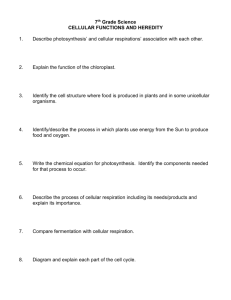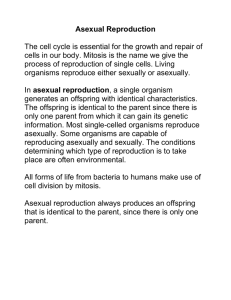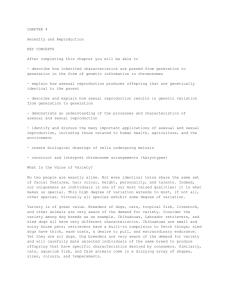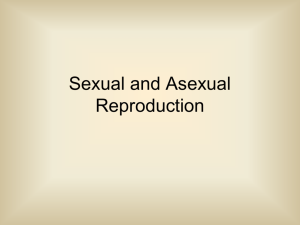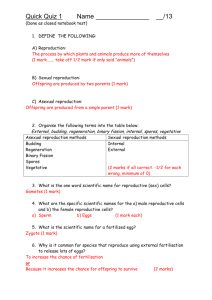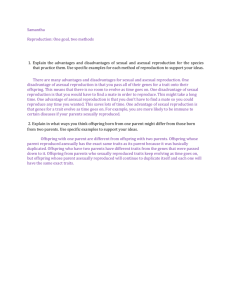Item 29. Most bacteria reproduce asexually. Mammals reproduce
advertisement
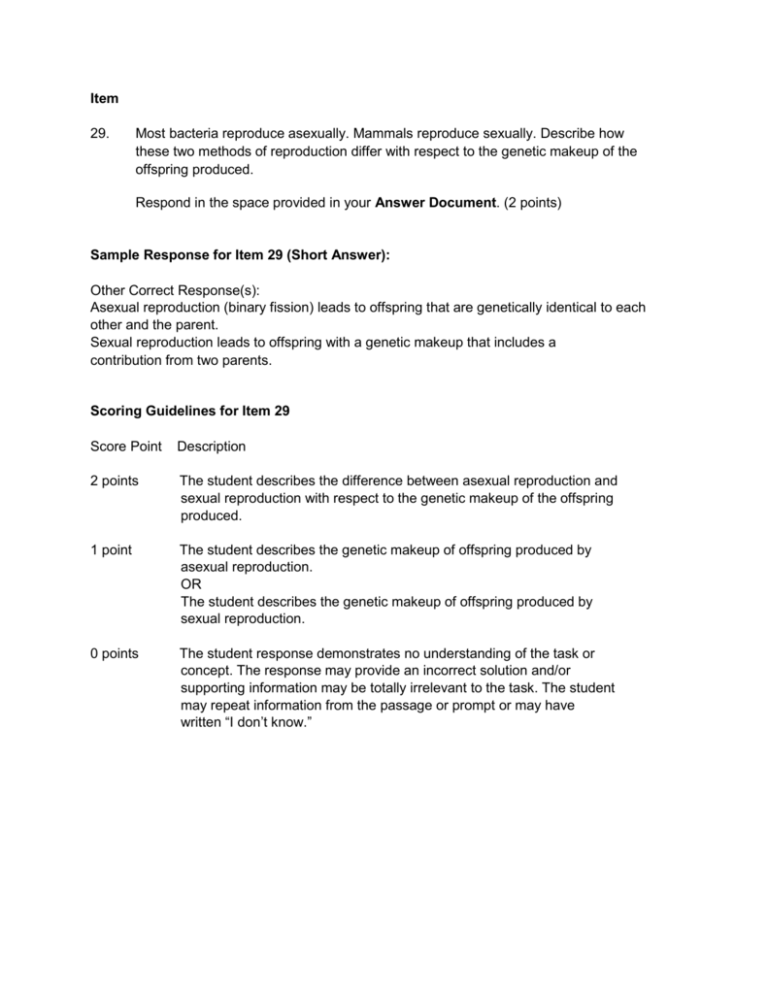
Item 29. Most bacteria reproduce asexually. Mammals reproduce sexually. Describe how these two methods of reproduction differ with respect to the genetic makeup of the offspring produced. Respond in the space provided in your Answer Document. (2 points) Sample Response for Item 29 (Short Answer): Other Correct Response(s): Asexual reproduction (binary fission) leads to offspring that are genetically identical to each other and the parent. Sexual reproduction leads to offspring with a genetic makeup that includes a contribution from two parents. Scoring Guidelines for Item 29 Score Point Description 2 points The student describes the difference between asexual reproduction and sexual reproduction with respect to the genetic makeup of the offspring produced. 1 point The student describes the genetic makeup of offspring produced by asexual reproduction. OR The student describes the genetic makeup of offspring produced by sexual reproduction. 0 points The student response demonstrates no understanding of the task or concept. The response may provide an incorrect solution and/or supporting information may be totally irrelevant to the task. The student may repeat information from the passage or prompt or may have written “I don’t know.” Score Point: 0 The response does not meet the criteria to receive one point. The response describes the process of sexual and asexual reproduction but does not provide a description of how the genetic makeup of the offspring differs. Score Point: 0 The response does not meet the criteria to receive one point. Description of the reproductive process does not address the prompt. Score Point: 0 The response does not meet the criteria to receive one point. The description of the offspring of asexual reproduction being “identical” is too vague to receive credit, as it is not clear whether it is referring to genetic makeup. The response does not provide a description of the genetic makeup of offspring produced by sexual reproduction. Score Point: 0 The response does not meet the criteria to receive one point. The description of the offspring of asexual reproduction as “clones” is not correct. While in some cases the DNA may be replicated with no errors, it is still possible for genetic mutations to occur during asexual reproduction. Score Point: 1 The response describes the genetic makeup of offspring produced by asexual reproduction. (“bacteria may reproduce with two offspring that came out to be the same.”) Score Point: 1 The response describes the genetic makeup of offspring produced by sexual reproduction. (“Sexual means they have characteristics of their parents”) Score Point: 1 The response describes the genetic makeup of offspring produced by asexual reproduction. (“When living things produce asexually ... The nucleus will divide so that one becomes two.”) Score Point: 2 The response describes the difference between asexual reproduction and sexual reproduction with respect to the genetic makeup of the offspring produced. (“reproduced asexually, it comes out to be identical to the parents or the creature it came from. ... sexually, it has traits and genetics from both parents and genes passed on by their parents.”) Score Point: 2 The response describes the difference between asexual reproduction and sexual reproduction with respect to the genetic makeup of the offspring produced. (“When bacteria reproduce, the daughter cell are exactly the same as the father cell. ...when mammals reproduce, the offspring aren’t exactly the same as one of the parents. They are part of each parent.”) Score Point: 2 The response describes the difference between asexual reproduction and sexual reproduction with respect to the genetic makeup of the offspring produced. (“If an organism reproduces asexually the offspring will be genetically identical to their parents. ... If an organism reproduces sexually, the mixing of genes increases the genetic variation of the offspring.”) Score Point: 2 The response describes the difference between asexual reproduction and sexual reproduction with respect to the genetic makeup of the offspring produced. (“When bacteria reproduce asexually, they only have their own genetic material to pass on, therefore producing near identical copies of the same bacteria … With mammals that produce sexually, mating occurs causing the mixture of genetic material from the male and from the female”) Score Point: 2 The response describes the difference between asexual reproduction and sexual reproduction with respect to the genetic makeup of the offspring produced. (“Asexually mean’s that the DNA will stay the same but only uses one parent…. sexually means that the DNA will have both parents genes in it.”)
